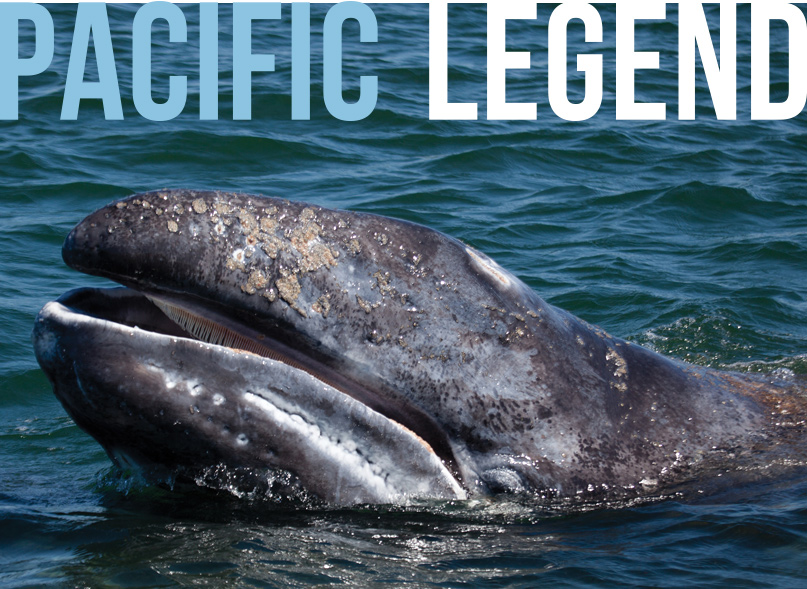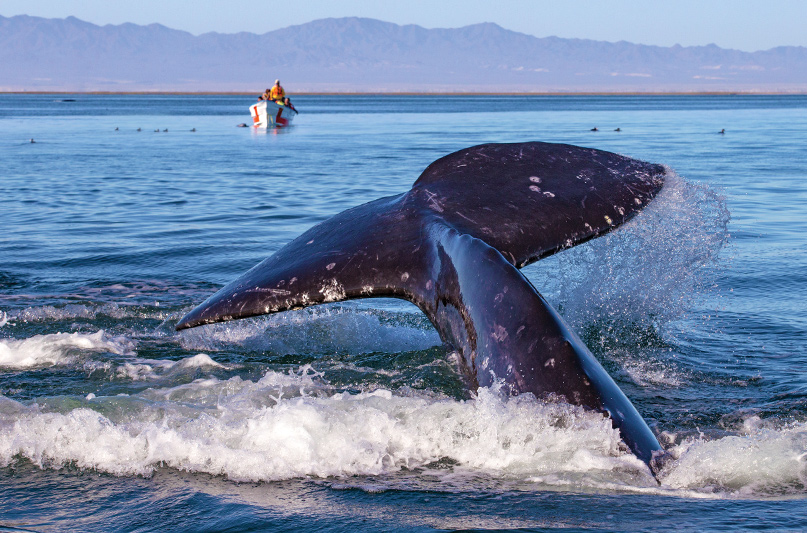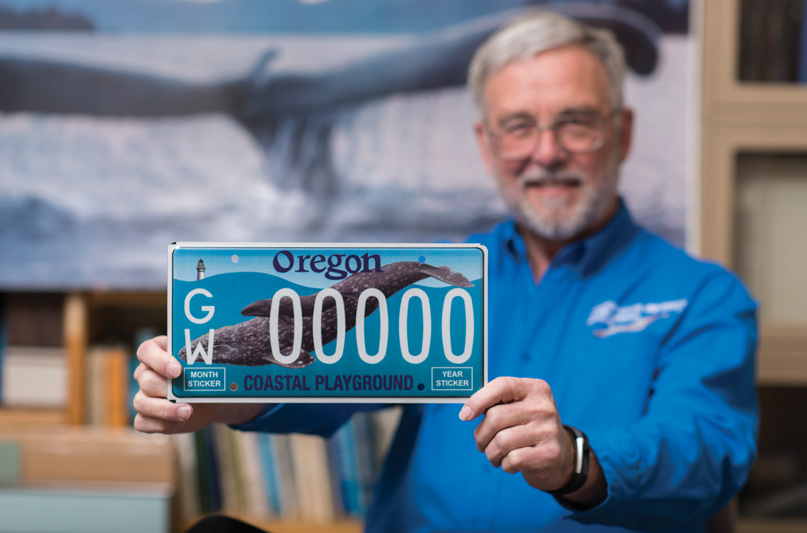
 Given that March is when these Silicon Forest hipsters of the whale world migrate past our coast and through the Salish Sea, boaters and landlubbers would do well to know a thing or two about these creatures unique to the west Pacific coast.
Given that March is when these Silicon Forest hipsters of the whale world migrate past our coast and through the Salish Sea, boaters and landlubbers would do well to know a thing or two about these creatures unique to the west Pacific coast.
Gray whales can be seen up and down the West Coast of North America, from the Baja peninsula in Mexico up to Alaska, multiple times a year depending on whether they are traveling north or south. Similar to other migration patterns, gray whales spend the northern hemisphere winter months in warmer, more southerly waters. Females will give birth to their calves in warm, sheltered lagoons such as San Ignacio in Baja California Sur, Mexico.
A special relationship has developed between the whale-watchers and the whales of San Ignacio. Whale-watchers can reach over the pontoon of a Zodiac and pet, scratch, or splash water on the whales, and the whales appear to enjoy this interaction and actively seek it out to the point that the whales will move on to another boat if the people choose not to interact. This vignette is a far cry from their “devil fish” days, a name for protective mother gray whales when their calves were targeted by whalers.
When it’s time, these whales will make like avid Pacific Northwest boater John Wayne and head north to Alaska. This is a long and sometimes perilous journey, often with predators like great white sharks and transient killer whales along the way. Most of these whales will feed opportunistically en route, but a majority of their feeding takes place in Alaska. They don’t stop their journey in Juneau or even Homer – they make their way to the shallow waters of the northwestern Bering and the Chukchi seas. Most pass by the Pacific Northwest as early as late January to as late as April, through Unimak Pass in the Aleutian Islands in April and May, continuing to move along the coast of Bristol Bay past Nunivak and St. Lawrence islands, and through the Bering Strait, arriving in May or June.

This trip, starting from Baja, is 5,000 to 7,000 miles one way! These migrations are one of the longest of any mammal in the world. Researchers satellite tagged a nine-year-old female gray whale they called Varvara and recorded her swimming from Sahkalin Island in Russia to Baja. This was unusual in that she originated from the small group of gray whales that live predominately in the western Pacific off the Russian coast, thought to not interact with the whales of the West Coast.
Regardless of whether this shows that these two previously believed distinct populations are actually one and the same, Varvara swam nearly 14,000 miles in one year – the longest confirmed migration of any mammal.
Their unique bottom feeding behavior incentivizes gray whales to remain in shallow water, and as a result makes them a great species for whale-watching not only from a boat, but also from the shore. The best time of year to see these whales in the Puget Sound is March and April. A small group of gray whales, known as the Pacific feeding group, do not go farther than the Pacific Northwest and are visible for a longer season in our region.
When looking for the whales, search for a heart-shaped, short, and puffy blow, and their gray mottled skin with white patches from barnacles, sea lice, and other parasites. They have no dorsal fin but look for the distinct ‘knuckles’ along the ridgeline of their back as they dive. Gray whales do breach (jump out of the water) and spyhop (stick their head out of the water, thought to be a way for whales to get their bearings).
As for places to go whale watching, one location that holds a special place in my heart is Depoe Bay in Oregon (my grandparents retired and lived here for many years). For such a small port (literally holding the title of “World’s Smallest Navigable Harbor”), this town hosts many people every year that come to see the resident gray whales that call this area home from March to December.
If you pass through Depoe Bay and see many cars pulled over and lots of people standing and looking out at the water, there’s a good chance there’s a whale or two (or more!) that can be easily seen from shore. Not only can you see them from land, but there are many opportunities to go out on local charters to see these whales even more closely and view whales shoreside in a matter of minutes. The Whale Watch Center, run by Oregon State Parks, has lots of information and park rangers to answer questions about the whales.
Given the nature of the gray whales’ migration route in that they tightly hug coastlines, there are many locations up and down the West Coast that are prime whale watching spots and have specific visitor’s centers centered around watching for gray whales. Pointe Vicente in Los Angeles on the Palos Verdes Peninsula, Cape Perpetua in Oregon, and Cape Flattery of Washington are all locations where gray whales can be easily spotted from shore.
An organization called the Whale Trail (thewhaletrail.org) shows West Coast whale locations and land-based viewpoints for great whale spotting from land. While their focus is primarily on southern resident killer whales, they list all other species that can be seen from these locations as well and is a great resource for whale-watching on the West Coast.
Given this is a boating magazine, there’s a good chance you’ll want to see whales from land or view them more intimately while fishing, sailing, or doing other activities out on the salt. In Puget Sound, check out Saratoga Passage on the east side of Whidbey Island. Those traveling on the Mukilteo Ferry often see a gray whale or two. The Orca Network (orcanetwork.org) can be a great resource for getting updates on where to see gray whales and orcas in the Salish Sea.
Whether you’re looking for whales or looking for fish, there are a few rules and reminders to keep in mind when in close proximity to marine mammals. Gray whales are protected under the Marine Mammal Protection Act (MMPA), which makes it illegal to harass a marine mammal. In addition to these rules, there are some new recommendations made by the Southern Resident Killer Whale (SRKW) Task Force appointed by Governor Jay Inslee.
In the February, 2019, issue of Northwest Yachting, our intrepid editor Norris Comer translated the recommendations made by the SRKW Task Force into plain language. The approaches of these recommendations include conserving Chinook salmon habitat, changing the number of hatchery salmon being bred and released, increasing enforcement in marine mammal harassment cases, and more diligently monitoring pollutants such as PCBs.

As a result of the concern over the decline of the SRKWs, enforcement of the rules in the MMPA will most likely increase. Whether this increased effort in enforcement will extend to other marine mammals besides the SRKWs remains to be seen, but as boaters, it is important to remember that the rules under the MMPA apply to all marine mammals. The regulations set by NOAA are that boaters must stay 100 yards away from whales (200 yards away specifically for SRKWs – this is a rule set by NOAA under the MMPA, not just a recommendation!), and that you must move on from viewing whales after 30 minutes.
Avoid approaching whales when other vessels are present and move on if the whales show any sign that they are disturbed. Do not cut them off or trap them in an area. More rules apply and can be reviewed here: fisheries.noaa.gov/insight/viewing-marine-life.
Unfortunately, there are stories every year of boat operators not following these rules. Speeding through groups of whales, following whales, and cutting off whales are all examples of irresponsible boater behavior, and technically can and should be enforced as crimes under the MMPA.
The Be Whale Wise campaign (bewhalewise.org) will continue in full force this summer, and with the current discussion over SRKW protection, it is likely the public, especially the boating community, will tolerate less from inconsiderate boaters. If you see anyone boating irresponsibly around marine mammals – SRKW, gray whales, or otherwise – don’t be afraid to contact the boaters over the radio and let them know that their behavior has been noted. Have the NOAA Office of Law Enforcement number on hand (1-800-853-1964) if their behavior persists. Be ready to provide a description of the vessel, or even better, take photos.

Perhaps the intensified attention cast over the SRKWs, though under unfortunate circumstances, will reap a side benefit for other marine mammals like gray whales. Gray whales will surely benefit from stricter regulations and enforcement of boater behavior around marine mammals.
To relieve some of the pressure off SRKWs, perhaps we can renew interest in the equally emblematic gray whales. As of February 1, Oregonians can now get a license plate with a graphic of a gray whale and calf to display your fondness for this Pacific Northwest symbol (and the associated surcharge goes to the Marine Mammal Institute). Why not pitch in for a cause? Our truly unique gray whales are symbols of our waters to the point where it’s impossible to imagine places like Depoe Bay or Saratoga Passage without them. Happy watching!